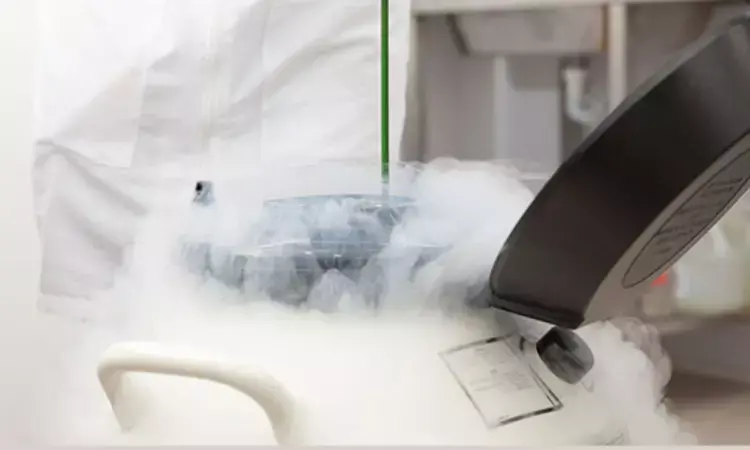- Home
- Medical news & Guidelines
- Anesthesiology
- Cardiology and CTVS
- Critical Care
- Dentistry
- Dermatology
- Diabetes and Endocrinology
- ENT
- Gastroenterology
- Medicine
- Nephrology
- Neurology
- Obstretics-Gynaecology
- Oncology
- Ophthalmology
- Orthopaedics
- Pediatrics-Neonatology
- Psychiatry
- Pulmonology
- Radiology
- Surgery
- Urology
- Laboratory Medicine
- Diet
- Nursing
- Paramedical
- Physiotherapy
- Health news
- Fact Check
- Bone Health Fact Check
- Brain Health Fact Check
- Cancer Related Fact Check
- Child Care Fact Check
- Dental and oral health fact check
- Diabetes and metabolic health fact check
- Diet and Nutrition Fact Check
- Eye and ENT Care Fact Check
- Fitness fact check
- Gut health fact check
- Heart health fact check
- Kidney health fact check
- Medical education fact check
- Men's health fact check
- Respiratory fact check
- Skin and hair care fact check
- Vaccine and Immunization fact check
- Women's health fact check
- AYUSH
- State News
- Andaman and Nicobar Islands
- Andhra Pradesh
- Arunachal Pradesh
- Assam
- Bihar
- Chandigarh
- Chattisgarh
- Dadra and Nagar Haveli
- Daman and Diu
- Delhi
- Goa
- Gujarat
- Haryana
- Himachal Pradesh
- Jammu & Kashmir
- Jharkhand
- Karnataka
- Kerala
- Ladakh
- Lakshadweep
- Madhya Pradesh
- Maharashtra
- Manipur
- Meghalaya
- Mizoram
- Nagaland
- Odisha
- Puducherry
- Punjab
- Rajasthan
- Sikkim
- Tamil Nadu
- Telangana
- Tripura
- Uttar Pradesh
- Uttrakhand
- West Bengal
- Medical Education
- Industry
Prolonged lung preservation at ten degrees celsius safe and improves transplantation performance and logistics: NEJM

Canada: The current practice of lung transplantation involves performing transplants on a 24/7 schedule; many procedures occur overnight to minimize organ ischemic time. Recent preclinical studies have shown superior graft preservation at ten °C versus the storage in an ice cooler, i.e. the gold standard.
A recent study published in NEJM Evidence has shown that extending cold static preservation times at ten °C appears safe and potentially improves transplantation performance and logistics.
The study revealed that lung transplantation after prolonged preservation at ten °C led to low rates of primary graft dysfunction (PGD). Early outcomes are the same as those of lungs transplanted using conventional methods having significantly shorter preservation times.
"A prolonged window of 12 to 18 hours of cold static preservation at the temperature of 10°C can potentially change the landscape of lung transplantation," the researchers wrote.
Donor lung preservation is performed by cold flushing the organ with a lung preservation solution, inflating it with oxygen, and storing it on ice. Due to its low cost and simplicity, the method continues to be used. There is no clarity on the maximum acceptable clinical preservation time on ice; generally, clinically, an organ with an ischemic time greater than 8 hours is usually considered to be high risk.
Aadil Ali, University of Toronto, Toronto, Canada, and colleagues hypothesized that lung preservation at 10°C may be feasible to extend clinical lung preservation times safely. They aimed to show safety within a patient cohort subjected to delayed transplantation using 10°C static lung preservation. Secondarily they aimed to compare these outcomes in patients transplanted contemporaneously using standard methods in a prospective, multicenter, nonrandomized clinical trial.
For this purpose, they studied transplants from donors with overnight cross-clamp times (6:00 p.m. to 4:00 a.m.) having an earliest allowed starting time of 6:00 a.m. Lungs meeting the transplantation criteria were retrieved, transported, and transferred immediately at 10°C temperature-controlled incubator until implantation. The study included 70 patients and 140 matched controls.
The study led to the following findings:
- Total preservation times for lungs in the study group were 12 hours, 28 minutes and 14 hours, and 9 minutes for the first and second lung implanted, respectively.
- Primary graft dysfunction grade 3 at 72 hours (primary outcome) was 5.7% in the study group versus 9.3% in matched controls.
- No meaningful differences were observed in the need for postoperative extracorporeal membrane oxygenation (5.7 versus 9.3%), median intensive care unit stays (5 versus five days), or median hospital stay (25 versus 30 days) between the two groups.
- One-year Kaplan–Meier survival was similar between the two groups (94 vs. 87%; hazard ratio, 0.65).
"Extension of cold static preservation times at 10°C appears safe and can potentially improve transplantation logistics and performance," the researchers conclude.
Reference:
The study "Extension of Cold Static Donor Lung Preservation at 10°C" was published in NEJM Evidence.
Dr Kamal Kant Kohli-MBBS, DTCD- a chest specialist with more than 30 years of practice and a flair for writing clinical articles, Dr Kamal Kant Kohli joined Medical Dialogues as a Chief Editor of Medical News. Besides writing articles, as an editor, he proofreads and verifies all the medical content published on Medical Dialogues including those coming from journals, studies,medical conferences,guidelines etc. Email: drkohli@medicaldialogues.in. Contact no. 011-43720751


